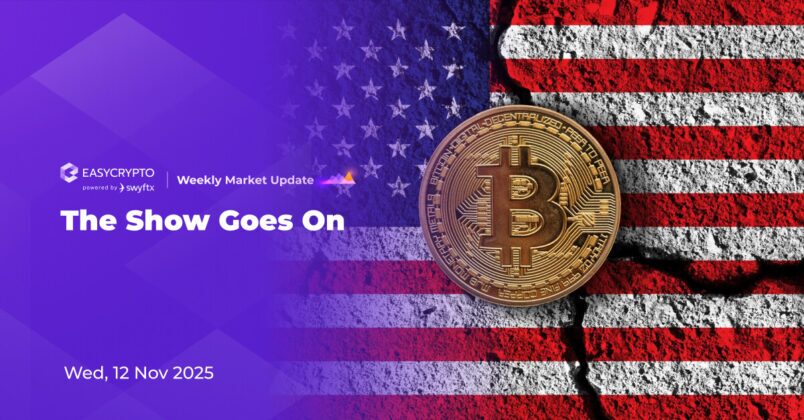Weekly Market Update: The Fog of Trade War
Crypto’s bull run is facing major headwinds from global market turmoil, inflation fears, and Trump’s escalating trade war. But history suggests that once the dust settles, the next big move could be explosive.


Rumors are swirling about significant capital flowing into the crypto market, but the reality on the ground doesn’t match the hype – positive headlines just aren’t translating into tangible gains. Even with seemingly bullish developments, the crypto market lacks the independent strength to push upward when broader macro forces are dragging everything down.
Take the current environment: a global stock market sell-off, driven by concerns over slowing growth and lingering long-term inflation, tends to hit risk assets like Bitcoin and Ethereum the hardest.
For instance, in 2022, when the S&P 500 dropped nearly 20% amid inflation fears and Federal Reserve rate hikes, Bitcoin plummeted over 60% from its highs. Crypto doesn’t just follow the stock market – it amplifies the gains but also pain.
Investors are understandably jittery, unsure of what’s around the corner, while the savvier players, the so-called “smart money”, are quietly making their moves, positioning themselves for what’s next.
This crypto bull market has followed a familiar rhythm but with some fresh twists: dips are being snapped up at lightning speed, and breakouts are hitting with less predictability – leaving patterns and clues of smart money accumulation.
The impact of Trump and his trade war is being felt around the world as collective anxiety peaks ahead of the next round of tariff announcements on 2 April (the so-called “Liberation Day”).
There is a faint echo and even some déjà vu from Trump’s first term’s pattern of political posturing and market jostling – promises of deregulation, tax cuts, infrastructure spending, energy security and tightening immigration policies – he’s making similar moves but the reality of these doesn’t seem to be moving the market in the right direction this time.
Looking back at Trump’s first term (2017-2021), the stock market saw strong gains with the S&P 500 rising nearly 9% in the first six months driven by widespread optimism.
The crypto market moved upward too, but its major surge came later once the dust had settled and the chaos had cleared. It wasn’t until mid-2017, starting in July, that Bitcoin really took off climbing from about $2,800 to nearly $20,000 by year-end in a legendary run.
They say history doesn’t repeat, but it often rhymes!
Do we have to wait a few more months for the chaos of Trump’s Trade War to simmer down, inflation to cool and the Fed to cut rates again and/or restart QE, before a crypto rally of real magnitude begins?
One thing we know for sure is that the markets want more certainty – and until then, we could be stuck in a holding pattern, vulnerable to every global hiccup.
Market sentiment tanked and then recovered a bit this week but is still showing: Fear
Highlights this week:
- BTC just closed its worst first quarter since 2018 down -11.6% closing at $82,538.
- Investor sentiment and Google search volume is well down on prior quarter highs as the market struggles to regain momentum for an enduring rally.
- Despite the price action, Bitcoin ETFs continued to accumulate with 10 days of positive inflows reflecting increased activity from institutional investors.
- At Easy Crypto, we saw an even buy:sell ratio for the month of March at 52:42%.
- ETH had another tough week down -7.8% at time of writing… If you invested $10,000 in $ETH exactly 3 years ago, you’d have just over $5,000 today!
- Other top Altcoins retraced prior weeks gains with XRP down -12.8%, SOL down -11.9% and DOGE down -8.9%.
- Most of the crypto market finished firmly in the red this week with a few exceptions.
- Surprise gainer of the week is EOS growing +21%.
- The biggest loser for the week is IMX down -25.7%.
View all top gainers: Visit the top gainers page to find out more.
Highlights from the crypto space
Despite a barrage of bullish headlines lighting up the crypto space lately, the market’s caught in the crosshairs of Trump’s Trade War; staggering under the pressure and too exhausted to bust out of this sideways grind.
When good news is bad news for price, then you know we’re paddling upstream!
GameStop shed nearly $3 billion in market cap after announcing plans to use proceeds from a $1.3 billion convertible debt offering to buy Bitcoin last week. Investors initially celebrated the news, sending shares up +12% on March 26, but sentiment quickly reversed the next day, pushing GME down by nearly -25%.
Even though 91% of the World Liberty Financial (Trump Family) portfolio is made up of Ethereum or Ethereum based tokens, ETH is down nearly -45% for the quarter, which rivals the start of the brutal bear market of Q1 2018 after the parabolic bull run in 2017.
It’s not all bad news, in another step forward, the U.S. Senate voted last week to repeal the controversial crypto tax rule that was introduced just before the Trump administration took office – the rule required certain ‘decentralised finance industry participants’ to operate like traditional securities brokers, mandating that they collect and report user trading data.
CME Group is partnering with Google Cloud to explore tokenization, using their Universal Ledger, to enhance capital market efficiency – by streamlining settlement and clearing. This move is part of a growing trend of traditional financial firms using blockchain technology for efficient, round-the-clock settlements.
On the other hand, the COO of MEXC crypto exchange, issued a warning that tokenizing real-world assets (RWAs) carries a substantial amount of centralised risks that can lead to censorship, liquidity issues, legal uncertainty, cybersecurity problems and asset confiscation through state or third-party intermediaries.
European financial institutions are significantly underestimating the demand for crypto services, with less than 20% offering digital asset products, according to a new survey by crypto investment platform Bitpanda. The study also found that 40% of business investors already hold crypto, with another 18% planning to invest in the near future.
The Trump family has deepened their crypto involvement by backing a new venture to launch what aims to become the world’s largest Bitcoin mining firm called American Bitcoin – partnering with Hut 8, a digital asset mining and infrastructure company.
Blackrock just said the quiet part out loud in their latest letter to shareholders: “If the U.S. doesn’t get its debt under control, if deficits keep ballooning, America risks losing that position to digital assets like Bitcoin”.
Ripple and the SEC have officially settled, with Ripple paying $50M and the remaining $75M returned, and the injunction set to be lifted pending final approvals.
xAI has acquired X in an ‘all stock’ transaction for $33 billion, which is a 25% discount to what Elon Musk originally paid for it. X (formerly Twitter) plans to launch its own in-app payments service “X Money” later this year – leaving many to wonder when and how he will integrate with crypto.
The crypto market lost over $1.6 billion to hackers in the last 3 months alone – Immunefi’s latest report claims that “Q1 2025 marks the worst quarter for hacks in the history of crypto.”
And “crypto muggings” are reportedly on the rise in the UK with robbers coming for the phones of cryptocurrency investors – grabbing them out of the victims’ hands.
In other crypto news…
- Controversial crypto influencer Ben Armstrong was arrested in Florida after allegedly sending threatening emails to a judge – he’s now stuck in jail with no bail.
- The U.S. Securities and Exchange Commission is dropping its investigation into Immutable, the Australian Web3 Gaming firm.
- President Trump has reportedly pardoned the three BitMEX co-founders.
- $6 trillion asset manager Fidelity is in the early stages of testing its own stablecoin – and is rumoured to be released ‘soon’.
- A full draft of the new U.S. STABLE Act of 2025 was released yesterday – the TLDR is stablecoins need to grow up and start playing by banking rules and ditch the crypto casino vibes.
- Bitcoin Mining Giant MARA is set to raise another $2 billion by issuing more stock to stack more Bitcoin.
Streamline Your Crypto Taxes with Koinly
Stressed about crypto taxes? Koinly makes tax time easy with automated reports. First-time users in NZ & AU get 20% OFF with our code. This means less stress, more savings!
Claim your discount before 30 April 2025!
🌎 Macro news TLDR: Back into the storm
The markets were just starting to dust themselves off, shaking off the jitters from Trump’s trade war tantrums. Optimism was creeping back in – and whispers of softer tariffs had Wall Street daring to dream of a broad market rally.
The spotlight was swinging toward looser monetary policy, with investors licking their chops for a fresh flood of capital to ignite the next big rally. It was all green shoots and good vibes – until, out of nowhere, Trump slammed the gas pedal on the trade war and we roared straight back into chaos.
The S&P face-planted, shredding over $100 billion per trading hour between Wednesday and Friday last week! And every asset class was feeling the impact – except Gold as it has closed the first quarter at new record highs.
Those tender sprigs of hope? Trampled flat under the boots of reality.
Attention snapped back to the looming “Liberation Day” and a smorgasbord of powder kegs ready to blow. Zelensky changed his mind at the negotiating table, Trump turned on Putin, China gave BlackRock the cold shoulder in Panama, and Israel decided it was time to crank the Middle East conflict back up.
We are out of the eye and back into the storm folks!
U.S. economic news
Global auto stocks led a broad market selloff from mid-last week on President Trump’s surprise announcement of a 25% tariff on all cars ‘not made in the United States’ – he then went on to threaten even larger tariffs if the EU and Canada join forces to do ‘economic harm’. Needless to say the markets didn’t like it one bit!
Trump clarified that Tesla CEO Elon Musk, a key advisor, did not influence the tariff decision, citing a possible conflict of interest and saying “he’s never asked me for a business favour”.
Tesla stock price has been struggling as of late, down -36% in the first quarter, and a new report reveals that owners are trading in their vehicles at record pace – some in protest and others in fear of the many criminal incidents involving the vandalizing of Tesla vehicles across the U.S.
More Trump Trade War chaos is expected this week as markets brace for the 2nd of April called “Liberation Day” where it is widely expected that a fresh round of far reaching reciprocal tariffs will be announced – there is speculation that 20%+ tariffs are coming for up to 25+ countries. Allies and markets alike are growing anxious.
The US just posted a 2-month goods trade deficit of $301 billion as companies attempt to front-run tariffs – we’ve rarely seen a trade deficit even half as large, a clear sign of panic!
Adding another blow, the Commerce Department reported a rise in core price inflation of +2.8% compared with a year ago, which was higher than January’s figure of +2.7% and above the Feds +2% target – raising concerns of stagflation.
U.S. oil production could be reaching its peak output as the country’s top producers are facing aging oilfields – the Permian Basin was the centre of the shale revolution that began nearly two decades ago and spurred the U.S. to become the world’s top oil producer.
U.S. Vice President J.D. Vance on Friday accused Denmark of not doing a good job keeping Greenland safe and suggested the United States would do better – this was ahead of his visit that was met by strong opposition from locals.
Over in Europe…
The Russia: Ukraine peace deal is on shaky ground again as President Zelensky said Ukraine would not accept any mineral rights deal that threatened its integration with the EU – and would not recognise the billions of dollars of past U.S. aid as loans – claiming the agreement was “entirely different” from an earlier framework.
The Middle East peace agreement is also on shaky ground as Israel carried out its first major airstrike in months on Beirut, retaliating for an earlier rocket launch from Lebanon.
President Trump is reportedly “very angry” with Russian President Putin for calling for a transitional government to be put in place in Ukraine” – he said: “If Russia and I are unable to make a deal on stopping the bloodshed in Ukraine, and if I think it was Russia’s fault, I am going to put secondary tariffs on oil, on all oil coming out of Russia.”
The U.S. is wreaking havoc around the world as shown by the Economic Policy Uncertainty Index that has hit new highs, even passing the height of the Covid 19 pandemic.
Britain’s Finance Minister last week announced billions of welfare spending cuts as she looked to plug a budget shortfall amid stalling economic growth, sticky inflation and higher borrowing costs in recent months. It might well be too early to say that the UK economic recession is in the review mirror.
German inflation came in at 2.3% in March, better than 2.4% forecast – bolstering the case for more ECB rate cuts. Keep an eye on the euro zone inflation report due out later this week.
And in Asia Pacific…
A massive earthquake ripped through Myanmar and Thailand with a state of emergency being declared in the capital Bangkok after dozens of workers were trapped in a collapsed skyscraper. The total death toll has passed 2,000 and economic losses are projected to be significant in what is being called the biggest earthquake in the world in the last 2 years.
Chinese regulators are delaying a U.S. consortium’s deal (led by Blackrock) for the purchase of two ports in the Panama Canal zone – China currently owns ports on both sides of the crucial maritime passage but the Canal remains in Panama’s control. President Trump has threatened to have the United States once again take control of the canal.
Australian Prime Minister Anthony Albanese has called a national election for 3 May as the country struggles with the high cost of living and rising U.S. tariffs. Opinion polls indicate the Labor party is currently running neck-and-neck with the conservative Liberal-National coalition – keep an eye on Polymarket as the time draws near.
In NZ, banks are in the spotlight again with questions around the pace of passing on recent OCR cuts: “Since the OCR started to come down in August last year, Kiwibank has taken 13.5 business days on average to make floating home rate changes for existing customers after each OCR decision”.
The RBNZ has announced an ‘evidence-based review’ of banks & other deposit takers capital requirements before the end of this year.
Finance Minister Nicola Willis has been exploring ways to pressure the bank into loosening its rules saying: “higher capital requirements increase the cost of borrowing. This can reduce economic activity and drive up the cost of living”.
That’s a wrap for this week!
Stay tuned for the next update
Did you miss the last weekly update?
Share to
Stay curious and informed
Your info will be handled according to our Privacy Policy.
Make sure to follow our Twitter, Instagram, and YouTube channel to stay up-to-date with Easy Crypto!
Also, don’t forget to subscribe to our monthly newsletter to have the latest crypto insights, news, and updates delivered to our inbox.
Disclaimer: Information is current as at the date of publication. This is general information only and is not intended to be advice. Crypto is volatile, carries risk and the value can go up and down. Past performance is not an indicator of future returns. Please do your own research.
Last updated April 2, 2025





